|
|
|
Sort Order |
|
|
|
Items / Page
|
|
|
|
|
|
|
| Srl | Item |
| 1 |
ID:
152685


|
|
|
| 2 |
ID:
139992
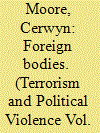

|
|
|
|
|
| Summary/Abstract |
This article examines foreign fighters and the insurgency in the North Caucasus. The first part of the article addresses conceptual issues concerning the ways that foreign fighters are analysed, posing this more widely in terms of transnational activism. Here I examine the importance of kin and relatedness. I develop this argument in the second part of the article, which examines pan-Islamism and transnational activism in the post-Soviet period. The third section draws attention to the different groups of foreign fighters, as part of a wider activist movement in the North Caucasus. Here I show that a complex group of transnational activists from the Greater Middle East, North Africa, parts of Europe, and Central Asia participated in the conflicts in the North Caucasus. Finally, the article turns to examine volunteers from the North Caucasus who travelled to fight in Syria, concluding with some considerations about the reintegration of returnees and former activists.
|
|
|
|
|
|
|
|
|
|
|
|
|
|
|
|
| 3 |
ID:
139996
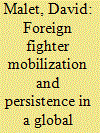

|
|
|
|
|
| Summary/Abstract |
Although foreign fighting is hardly new, scholarly research on the phenomenon is only a decade old. Since 2005, there has also been a dramatic rise in the number of transnational insurgents fighting in the Middle East, and they appear to have become the face of the jihad movement. However, of the dozens of foreign fighter contingents around the world in recent decades, only about half have been Islamists. In this article, I contend that the difference between the other contemporary and historical foreign fighter groups and the jihadis is not one of mobilization or effectiveness, but of persistence. Most other foreign fighters demobilized at the end of their conflicts and reintegrated. I argue that the primary factor that accounts for the persistence of the jihadis was the policies of their home and host states that prevented reintegration and created cohorts of stateless, and now professionalized, actors who perpetuate in weakly-governed conflict zones. In presenting this argument, I first attempt to establish a common working definition of foreign fighter based on the first decade of discourse in this emerging field of study, and present a comparative examination of the largest recorded foreign fighter mobilizations.
|
|
|
|
|
|
|
|
|
|
|
|
|
|
|
|
| 4 |
ID:
175739
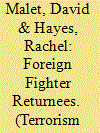

|
|
|
|
|
| Summary/Abstract |
How long does it typically take a returned foreign fighter to launch a domestic terror attack? The issue of returnees, and appropriate national and international responses to potential threats, has become a preeminent security concern of the 2010s, impacting policies on everything from refugees to whether to permit ISIS fighters to leave the theater of conflict alive. This article attempts to illuminate these contentious debates through a new data set of Lags in Attack Times of Extremist Returnees (LATER) that examines 230 jihadi returnees to Western countries. The data indicate that the majority of attempted attacks occur within one year, with a median lag time of just four months. Prison appears to play no role in lag times. Our findings indicate that security and reintegration efforts should be targeted within the critical six months after return, which diminishes the risk of attack considerably.
|
|
|
|
|
|
|
|
|
|
|
|
|
|
|
|
| 5 |
ID:
131133
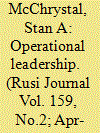

|
|
|
|
|
| Publication |
2014.
|
| Summary/Abstract |
Generating strategy may be easy, but implementing it is difficult. Initially understanding the problem is tough; worse, it may itself change as an operation goes on. Reflecting on his experience on recent campaigns in Iraq and Afghanistan, former US general and commander of ISAF, Stan A McChrystal, outlines the challenges of operational leadership and suggests some key lessons for leaders and policy-makers.
|
|
|
|
|
|
|
|
|
|
|
|
|
|
|
|
| 6 |
ID:
168494
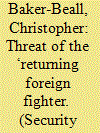

|
|
|
|
|
| Summary/Abstract |
This article analyses the European Union’s response to the threat of the ‘returning foreign fighter’ (referred to with increasing frequency as the ‘foreign terrorist fighter’), arguing that it has been characterized by a move to (re)frame migration and border control as essential aspects of EU counter-terrorism policy. The article offers three important observations on the significance of this move. First, it critiques the way in which the EU’s response to this problem is based upon and reinforces a narrow understanding of returning foreign fighters. Second, it argues that the EU has invoked the threat from returning foreign fighters not with the sole intention of preventing terrorism but rather as part of the ongoing securitization of migration and the EU border. Third, it suggests that the threat from returning foreign fighters has been invoked as a way of further legitimizing the EU’s emerging role as a security actor and its embrace of preemptive security practice. The article argues throughout that the move to construct the returning foreign fighter issue in this way has important political and social implications for all categories of migrant, with migrant populations now deemed a potential source of terrorist threat.
|
|
|
|
|
|
|
|
|
|
|
|
|
|
|
|
| 7 |
ID:
190898
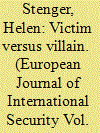

|
|
|
|
|
| Summary/Abstract |
State responses to repatriation of Islamic State (ISIS) foreign fighters and their children detained across Syria and Iraq are highly diverse. Repatriation policies implemented between 2018 and 2020 range from denying repatriation of nationals and revocation of citizenship to repatriation and subsequent gender-responsive rehabilitation programmes. What explains the variation in state responses? This article seeks to explain why repatriation policies differ despite the global challenges faced by all states. It investigates and categorises the repatriation policies for foreign fighters across 69 countries ranging from unconditional repatriation to denying repatriation. To explain the state responses to a common security and human rights dilemma, a mixed-method approach is employed involving an explorative statistical analysis to test key explanations and a narrative analysis. The findings reveal how diverse social constructions of gendered and racialised ‘threat narratives’ of foreign fighters in policy documents and the media explain variation in foreign fighter repatriation policies.
|
|
|
|
|
|
|
|
|
|
|
|
|
|
|
|
|
|
|
|
|